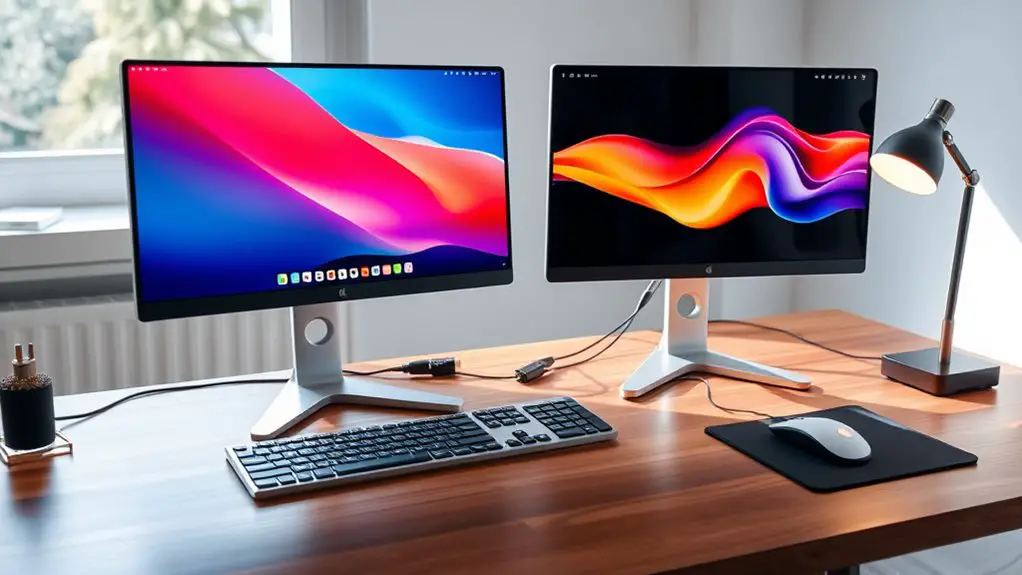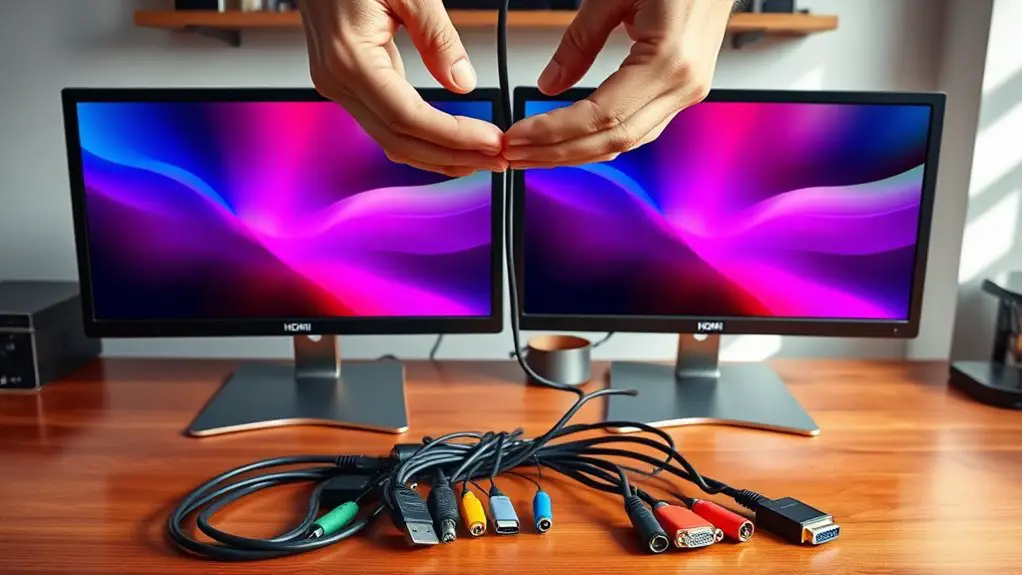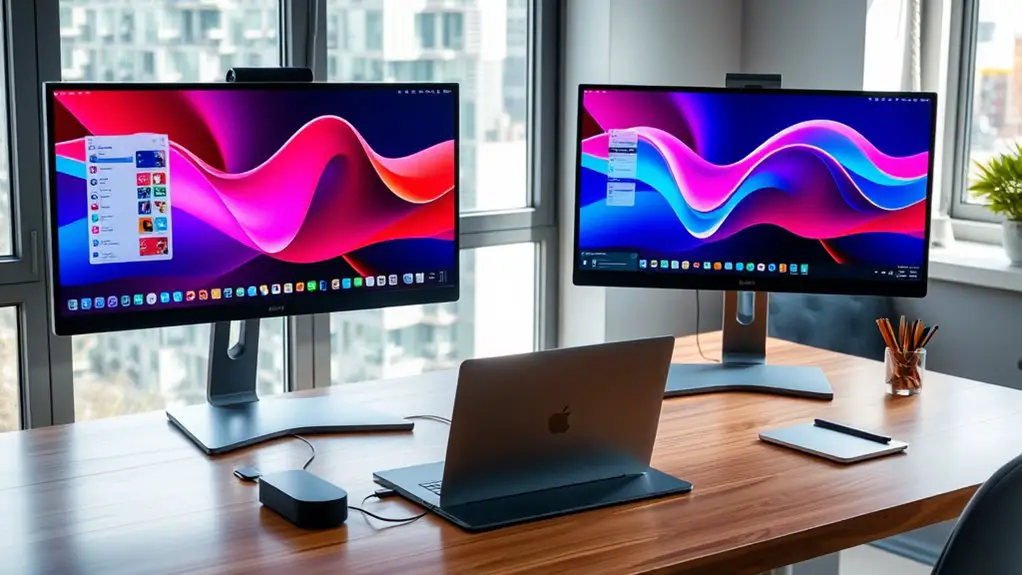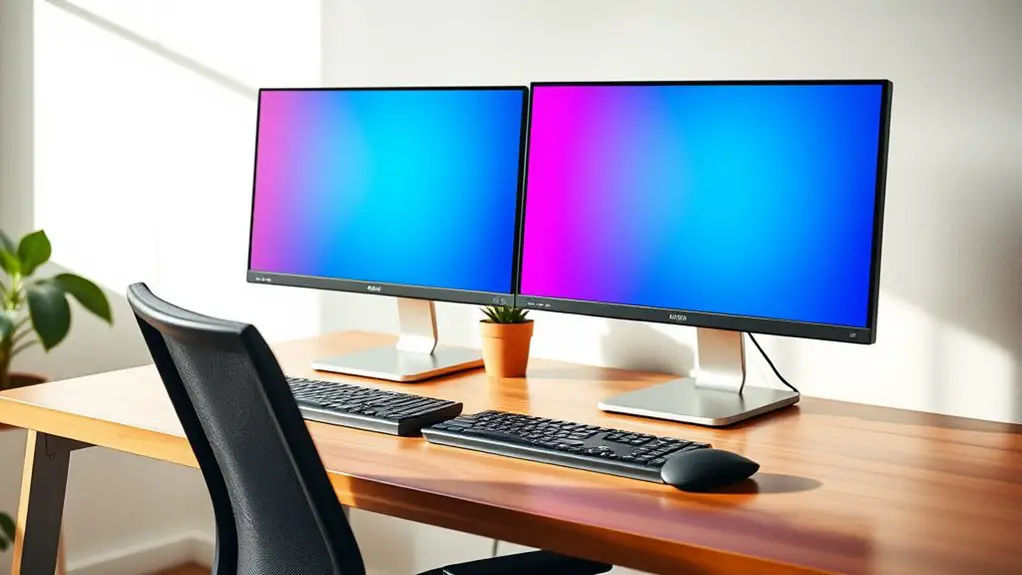Setting up dual monitors is easier than you might think! First, check your computer's compatibility and graphics card capabilities. Choose the right cables to connect your monitors and guarantee you have enough power sources. A docking station can simplify connections if you're using a laptop. Once connected, customize your display settings for a smooth experience. With a few tips and tricks, your dual monitor setup can be transformed into a powerful productivity tool. There's more to explore!
Key Takeaways
- Confirm your computer's compatibility with dual monitors by checking the motherboard and graphics card specifications for multi-display support.
- Choose the right cables (HDMI, DisplayPort, etc.) based on your monitors and ensure they are durable enough for your setup.
- Follow the specific connection procedures for your primary and secondary monitors, ensuring all cables are securely plugged in.
- Access display settings on your computer to configure monitor arrangement, resolution, and primary display selection for optimal usage.
- Organize your workspace ergonomically, positioning monitors at eye level and managing cables to reduce clutter and enhance productivity.
Understanding Computer Compatibility

When setting up dual monitors, understanding computer compatibility is crucial. Most motherboards support multiple displays, but older models might have limitations. If your motherboard has integrated video, it often supports dual monitors.
Understanding your computer's compatibility is essential for a successful dual monitor setup, especially with older motherboards.
Check the manufacturer's documentation for specific details on multi-display support. You'll also need to evaluate the available ports—common connections include HDMI, DisplayPort, and USB-C. Older systems may rely on VGA or DVI, which are less ideal. Multiple monitors enable simultaneous viewing of multiple windows, enhancing productivity.
If your ports don't match your monitors, adapters can help. Be certain to note that high-resolution monitors may require more powerful hardware.
Before you make any purchases, test your monitor inputs to verify compatibility and a seamless setup. This way, you're setting the stage for an efficient workspace.
Checking Your Graphics Card
How do you know if your graphics card can handle dual monitors? First, check the model of your graphics card to understand its capabilities. Many modern cards support multiple displays, often up to four. Look for a variety of ports like HDMI or DisplayPort, which you'll need for connecting your monitors. Next, examine the specifications—higher CUDA cores or stream processors typically mean better multitasking performance. Ample VRAM (8GB or more) and a wide memory bus are essential for high resolutions. Also, verify your system can power the card, especially if it's a high-end model. Additionally, ensure that your GPU has enough ports for dual monitor connections to maximize your setup's potential. With this information, you can confidently determine if your graphics card is ready for a dual monitor setup.
Choosing the Right Cables

Choosing the right cables is essential for ensuring your dual monitor setup functions smoothly and efficiently. Different cable types serve different needs, so you'll want to choose wisely. Here's a quick comparison of common cables:
| Cable Type | Key Features |
|---|---|
| HDMI | Supports audio and video, 4K ready |
| DisplayPort | Higher bandwidth, up to 16K |
| DVI | Video only, limited to 1080p |
| VGA | Older standard, not for high-res |
| USB-C | Supports video, audio, and data |
Ensure you check cable lengths and durability for your specific setup. Sometimes, you might need adapters for older monitors, so be prepared. Quality matters, so invest in reputable brands for reliability. Additionally, it's wise to consider future-proofing your setup by opting for cables that support the latest standards like HDMI 2.1 or DisplayPort 2.0.
Ensuring Power Sources for Monitors
Before you get your dual monitors up and running, make sure you have the right power cables for each display. Check that you have enough outlets available to accommodate both monitors without overloading your power source. This step is essential for a smooth setup and ideal performance. Additionally, ensure that your laptop has a compatible video card to support the extra monitor for optimal functionality.
Power Cable Requirements
Guaranteeing adequate power sources for your dual monitors is essential for ideal performance. Most monitors need a direct power connection, with power consumption varying from a few watts to over 20 watts for larger screens. If you're using USB-C monitors, remember that they can provide power while connecting to a laptop, but this is limited by the USB-C power delivery capacity, typically capped at 100W. Verify that your monitors, especially in daisy-chaining setups, support this feature. Standard AC cords are common for power connections, and if you're using docks, make sure they deliver sufficient power to meet your monitors' needs. Always double-check your cables and adapters for compatibility to avoid power issues. Additionally, dual monitors can significantly enhance your multitasking capabilities, making it easier to manage multiple applications efficiently.
Outlet Availability Check
After verifying that your monitors have adequate power connections, the next step is to assess outlet availability for your dual monitor setup. Confirming you have enough power sources is essential to avoid overload and maintain a tidy workspace.
Here are some key considerations:
- Verify each monitor has a dedicated power outlet nearby.
- Position your monitors to allow easy access to power outlets.
- Use power strips if you need to manage multiple devices efficiently.
- Keep cables organized with cable management solutions to prevent clutter.
Using Docking Stations for Laptops

When you're setting up dual monitors with a laptop, choosing the right docking station can make all the difference. It simplifies connecting multiple displays and enhances your port availability, giving you the flexibility you need for a seamless workflow. A good docking station also reduces cable clutter, creating a tidier workspace that promotes productivity. Let's explore how to select the ideal dock and maximize your setup.
Choosing the Right Dock
A docking station can transform your laptop into a powerful workstation, making it essential for anyone using dual monitors.
When choosing the right dock, consider the following key features:
- Types of Ports: Confirm it has the necessary ports, like HDMI or USB-C, for your devices.
- Power Delivery: Look for models that provide enough wattage to charge your laptop while in use.
- Multiple Monitor Support: Check if it can accommodate dual or triple monitors to enhance your productivity.
- Compatibility: Verify that the dock works with your laptop's operating system to avoid headaches later.
With the right docking station, you'll enjoy a seamless multi-monitor experience that boosts your efficiency and keeps your workspace organized. Additionally, ensure the dock has various port options to meet your peripheral needs efficiently.
Connecting Multiple Displays Easily
Connecting multiple displays can greatly enhance your productivity, especially when using a docking station for your laptop. First, choose a docking station that supports multiple monitors with ports like HDMI, DisplayPort, or USB-C. Check your laptop's compatibility to guarantee it can handle dual displays. Additionally, using external monitors can improve overall workflow efficiency.
Once connected, manage your cables neatly with ties or clips for a tidy workspace. If your docking station supports daisy-chaining, you can expand your monitor options easily. Don't forget to adjust your display settings in your operating system to optimize your setup. Configure your monitors in extended mode for separate tasks or mirror mode for duplication.
With the right setup, you'll enjoy a more efficient workspace in no time.
Enhancing Port Availability Options
With the right docking station, you can substantially boost your laptop's port availability, making it easier to connect multiple devices. Docking stations come equipped with various ports that enhance your setup, allowing for seamless multitasking. Here are a few key features to look for:
- USB-C Ports with Power Delivery for charging and data transfer.
- Multi-Stream Transport (MST) support to manage multiple displays from a single output.
- Compact Designs that fit easily into bags for portability.
- Compatibility with Various Brands like HP and Manhattan Products, ensuring you find a suitable option. Additionally, a good docking station supports dual UHD HDMI monitors, allowing you to work more efficiently with multiple screens.
Using a docking station not only simplifies your connections but also enhances productivity with high-speed transfers and stable network connections.
Connecting Your Primary Monitor
To successfully connect your primary monitor, start by determining the appropriate connection type that matches both your monitor and computer. Most modern setups use HDMI due to its universal compatibility, but DisplayPort offers higher bandwidth for detailed graphics. If you're dealing with older technology, you might encounter DVI or VGA connections. Confirm you have the right cables and check that your computer has the necessary two available connections for external displays.
Once you've confirmed everything, power on the monitor and connect it to your PC. After turning on your computer, it should automatically detect the monitor. If not, you may need to manually adjust settings in your display menu. Verify everything is working properly before moving on to your secondary monitor setup.
Setting Up the Secondary Monitor
Now that you've connected your primary monitor, it's time to set up the secondary one.
Start by choosing the right cable to guarantee a solid connection, and then configure your display settings to arrange both screens as you prefer. Setting up a dual monitor workspace will help you maximize your workspace and improve productivity.
Choosing the Right Cable
Selecting the right cable for your secondary monitor can greatly impact your setup's performance and quality.
The choice of cable affects not just resolution but also audio and data transmission. Here are some key options to evaluate:
- HDMI: Great for multimedia, transmitting both audio and video.
- DisplayPort: Ideal for high resolutions and refresh rates, especially in gaming.
- DVI: A solid choice for digital video but lacks audio support.
- VGA: Outdated and only supports analog signals, requiring a separate audio connection.
Make sure your monitor and PC ports match or use adapters when necessary. Additionally, consider that HDMI supports high resolutions and is widely used in modern setups. Also, check the cable length needed for your setup to avoid restrictions in monitor placement.
Configuring Display Settings
Once you've connected your monitors with the right cables, it's time to configure the display settings for peak performance.
Right-click on your desktop and select "Display settings." Make sure both monitors are powered on. You'll see each monitor represented as a numbered box. To identify them, click the "Identify" button next to each option.
Choose your primary monitor by clicking its box and checking "Make this my main display." The second monitor will automatically become your secondary display. Additionally, configuring dual screen setup enhances productivity and multitasking capabilities.
Align the monitors for smooth mouse movement by dragging their numbered boxes. Use the "Multiple displays" dropdown to decide how your secondary monitor behaves, and adjust resolution and scaling to fit your needs for clarity and usability.
Configuring Display Settings
To configure your display settings effectively, start by right-clicking on your desktop and selecting "Display settings." This action opens up a menu where you can manage your monitor configurations.
Verify both monitors are recognized before making any changes. If one isn't showing, check the connections. Use the "Identify" feature to determine which monitor corresponds with which number.
Here are some key adjustments you might consider:
- Select your primary display by clicking the numbered box and checking "Make this my main display."
- Adjust resolution settings for best clarity.
- Use the "Multiple displays" dropdown to choose your preferred arrangement.
- Rearrange monitors using the drag-and-drop interface for a seamless experience.
Optimizing Your Workspace
How can you create an efficient and comfortable workspace with dual monitors? Start by choosing the right monitors with adequate size and resolution, like Full HD or 4K, to enhance your multitasking. Verify they're compatible with your computer's ports.
An L-shaped desk can provide flexibility, allowing you to designate separate areas for tasks. Position your monitors side by side, aligning their top edges to minimize visual strain. This setup increases productivity by allowing simultaneous application use, making it easier to complete tasks efficiently.
Ergonomic furniture, like adjustable chairs and keyboards, will help maintain comfort. Add adjustable task lighting to reduce glare, and incorporate some ambient lighting for a pleasing atmosphere.
Finally, don't forget to manage cables with clips or trays, keeping your workspace neat and organized for peak productivity.
Troubleshooting Common Issues
Setting up dual monitors can sometimes lead to unexpected issues, but troubleshooting them doesn't have to be intimidating. Start by checking your connections; make sure all cables are securely plugged in and verify the correct input port is selected on each monitor.
If you're still having trouble, consider these tips:
- Verify both monitors are powered on.
- Update your graphics drivers to maintain compatibility.
- Use Windows settings to detect additional monitors.
- Disconnect unnecessary peripherals that could cause interference.
Additionally, refreshing Windows by pressing Windows Logo + Ctrl + Shift + B keys simultaneously can help resolve certain display issues.
With these steps, you can swiftly identify and resolve most common issues.
Don't hesitate to restart your system or reset your graphics driver if problems persist. Keeping things simple often leads to a smoother dual-monitor experience.
Advanced Customization Options
After troubleshooting common issues, you can take your dual monitor setup to the next level with advanced customization options.
Both Windows and Mac let you drag and drop display icons, allowing you to arrange monitors based on your physical setup. Adjusting the display settings according to monitor sizes or resolutions is essential for efficient workspace planning. Using the same resolution across all monitors ensures a seamless experience while transitioning between screens.
You can also set monitors to different orientations, like landscape or portrait, depending on your needs. For better visuals, verify each monitor runs at its native resolution while utilizing custom scaling for independent size adjustments.
Finally, access advanced features by pressing Windows Key + P or through Mac's Display Preferences to enhance your multitasking capabilities.
Tips for a Seamless Dual Monitor Experience
To achieve a seamless dual monitor experience, you'll want to focus on both your physical setup and display configurations.
Start by ensuring your monitors are ergonomically positioned at eye level and angled slightly to reduce glare. Choose monitors with compatible resolutions, like 27-inch QHD, and adjust brightness for uniformity.
Ensure your monitors are at eye level and slightly angled to minimize glare while maintaining consistent brightness for an optimal viewing experience.
Here are some tips to enhance your setup:
- Organize your desk to provide ample space for both monitors without clutter.
- Use adjustable mounts to achieve ideal viewing angles and reduce neck strain.
- Utilize display settings to arrange monitors according to their physical layout, ensuring you can easily rearrange displays if needed.
- Manage cables effectively to maintain a clean and organized workspace.
These steps will help you enjoy a more productive and comfortable dual monitor experience.
Frequently Asked Questions
Can I Use Different Monitor Brands Together?
Yes, you can use different monitor brands together. Just make certain they have compatible connectors and adjust settings like resolution. Experimenting with arrangements can improve your experience, making your workspace more efficient and enjoyable.
How Do I Switch Between Monitors Quickly?
To switch between monitors quickly, you can move your mouse cursor across screens or use keyboard shortcuts like ALT+TAB for windows. Additionally, consider third-party tools for custom shortcuts to streamline your experience.
Will Dual Monitors Slow Down My Computer?
Dual monitors usually won't slow down your computer during regular tasks. However, if you're running resource-intensive applications or high resolutions, it's crucial to verify your GPU's powerful enough to handle the extra load.
Can I Extend My Desktop to a TV?
Yes, you can extend your desktop to a TV. Connect via HDMI or use Miracast if supported. Just adjust your display settings in Windows to configure how you want your screens to work together.
What if One Monitor Shows a Blank Screen?
If one monitor shows a blank screen, check the cables and connections. Verify the correct input is selected, and access display settings to confirm it's recognized. Restart both monitors and your computer to refresh the connection.
